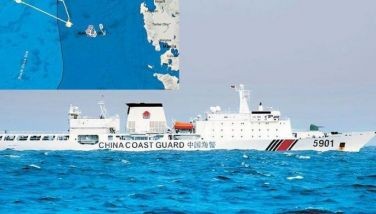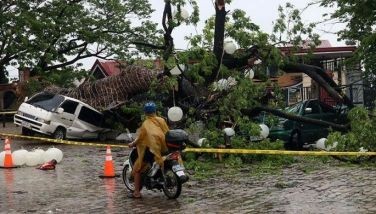RP ranks 12th among 200 countries most at risk from disasters
MANILA, Philippines - The Philippines ranks no. 12 among 200 countries most at risk from tropical cyclones, floods, earthquakes and landslides, United Nations International Strategy for Disaster Reduction (UNISDR) senior regional coordinator Jerry Velasquez disclosed yesterday.
“The Philippines is among the disaster-prone countries in the world most vulnerable to cyclones, storms and climactic events,” said Velasquez, citing a recently released UNISDR Mortality Risk Index (MRI) that rated the Philippines “very high” in terms of average number of citizens at risk from natural calamities.
At the Senate committee on climate change onsite hearing in Nangka, Marikina last Tuesday, Velasquez also cited a study funded by Canada and Sweden conducted last January which found that of the ten ASEAN countries, the Philippines is a “hot spot” for cyclones, landslides, floods and droughts.
“In fact, according to this study’s multiple climate hazard index, the Philippines received a rank of 0.6 to 1.0, the highest among all countries in the ASEAN,” Velasquez said.
The same study listed the most vulnerable provinces or districts in Southeast Asia wherein the National Capital Region (NCR) ranked seventh among all cities in the ASEAN, with Cordillera in 27th spot and Central Luzon 30th.
The UN report also revealed that while a single event cannot be attributed to climate change, extreme weather conditions like tropical storm “Ondoy” and typhoon “Pepeng” are consistent with the trend that the Intergovernmental Panel on Climate Change identified in its 4th Assessment Report.
Velasquez agreed that the latest weather disturbances in the country meant that climate change was already in our midst, citing the historic data of the Philippine Atmospheric, Geophysical and Astronomical Services Administration (Pagasa) that the mean annual temperature in the country from 1951 to 2006 increased by 0.6 degrees centigrade with the minimum annual rising by 0.89 degrees centigrade over the same period.
From 1964 to 2004, Pagasa reported that there has been a decrease of 500 million cubic meters of cumulative annual water inflow in Angat Dam and from 1948 to 1994, sea level rose by 40 cm in Manila and by 20 cm in Davao and Legazpi.
The Senate committee led by Sen. Loren Legarda conducted the hearing Tuesday afternoon at the Balabad Settlement area, Barangay Nangka, one of the barangays in the city most affected by Ondoy.
Legarda stressed at the hearing that the people must learn from the lessons of Ondoy and Pepeng as she urged everybody to do their part in helping maintain a balanced environment.
Legarda said the factors that heighten disasters are poor urban governance, ecosystems decline and the vulnerability of the sources of livelihood in rural areas.
“It’s a vicious cycle of poverty and disaster vulnerability. The deadly trio of haphazard urban development, ecosystems decline and unstable livelihood – individually and in combination – drives disaster risk and provokes catastrophe, especially in poor communities,” she said.
Floodwaters coming from the nearby Marikina River inundated even two-story houses last Sept. 26.
The onsite Senate hearing was done in an urban settlement area in a Nangka where some 6,000 families were affected by the floods.
Rebuilding lives
Val Obana, barangay administrative officer, said he and his neighbors have started to rebuild their lives with the help of the local government under Marikina Mayor Marides Fernando, who also participated in Tuesday’s hearing.
Apart from relief goods, Obana said the community also expressed gratitude to the Tzu Chi Buddhist Foundation, a Taiwan-based foundation, which led the cleanup efforts in their barangay for the past four weeks. The group spearheaded the cleanup participated by 2,600 t 3,000 local residents who were given P400 day salary for their “job.”
RP lacks capability to address climate change
The UN Global Assessment Report (GAR) for 2009 was also launched at the hearing. The report stressed the need for the Philippines to address climate change because it lacks enough capability to cope with disasters.
A UN study showed that the Philippines ranked seventh among the ten ASEAN countries, ahead of Lao PDR, Malaysia and Myanmar in coping with disasters.
If not enough mitigating measures are put up, the Philippine climate scenarios showed that an increase in temperature for the country by 1.8 degrees centigrade by 2050 and up to 3.6 degrees centigrade by 2070.
The study also projects an increase in intense precipitation and an increase of up to 20 percent in tropical cyclone intensity and the amplification in storm-surge heights, resulting in an enhanced risk of coastal disasters.
Similarly, the UN report noted a similar analysis by the World Wildlife Fund (WWF) on the Manila Bay area, which suggests that a 100 cm rise in sea level by 2080 would lead to over 5,000 hectares of the bay area being regularly inundated, affecting over 2.5 million people. This would also mean that densely populated areas of Malabon and Navotas would experience more frequent inundation, Velasquez said.
He lamented that the Philippines was last to ratify the ASEAN agreement on Disaster Management and Emergency Response (AADMER) and that Indonesia overtook the Philippines in the passage of its own disaster risk management legislation that it patterned after the Philippines. The Philippine legislation is yet to pass its own bill in Congress.
Fighting leptospirosis
Meanwhile, chief epidemiologist Dr. Eric Tayag reported that there were 313 reported leptospirosis cases in Marikina with 13 deaths from Oct. 1 to 26. In the NCR, there were 2,158 cases with 107 deaths.
Tayag said the health department is still monitoring the cases in Marikina City. While there are no rains, Tayag noted that the virus is still present in mud that can contaminate the once-flooded areas.
To avert further leptospirosis outbreak, Marikina City Mayor Fernando said her team is working on the possibility of launching the “Find the Rats” contest among residents.
The mayor said her team came up with the idea of catching rats, which are carriers of the virus.
The city government is mulling to a reward of P10 for every rat caught.
Tayag, however, cautioned Fernando on the implications of the contest, citing an instance where a province launched a similar campaign against cockroaches but the drive failed because residents made a livelihood of it by breeding roaches.
- Latest
- Trending





























